#did this in 10 minutes on a web browser art program at 1 am
Explore tagged Tumblr posts
Text
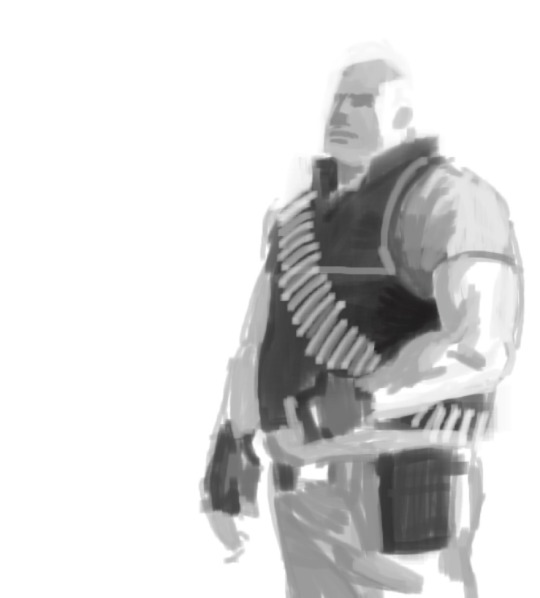
First ever heavy drawing attempt
#went to a weightlifting competition and gor inspired#heavy#tf2 heavy#tf2#team fortress#team fortress 2#did this in 10 minutes on a web browser art program at 1 am#so dont judge the awful quality#my art
221 notes
·
View notes
Text
20 years a blogger
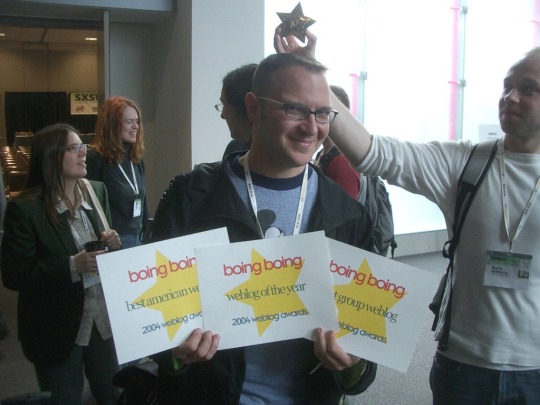
It's been twenty years, to the day, since I published my first blog-post.
I'm a blogger.
Blogging - publicly breaking down the things that seem significant, then synthesizing them in longer pieces - is the defining activity of my days.
https://boingboing.net/2001/01/13/hey-mark-made-me-a.html
Over the years, I've been lauded, threatened, sued (more than once). I've met many people who read my work and have made connections with many more whose work I wrote about. Combing through my old posts every morning is a journey through my intellectual development.
It's been almost exactly a year I left Boing Boing, after 19 years. It wasn't planned, and it wasn't fun, but it was definitely time. I still own a chunk of the business and wish them well. But after 19 years, it was time for a change.
A few weeks after I quit Boing Boing, I started a solo project. It's called Pluralistic: it's a blog that is published simultaneously on Twitter, Mastodon, Tumblr, a newsletter and the web. It's got no tracking or ads. Here's the very first edition:
https://pluralistic.net/2020/02/19/pluralist-19-feb-2020/
I don't often do "process posts" but this merits it. Here's how I built Pluralistic and here's how it works today, after nearly a year.
I get up at 5AM and make coffee. Then I sit down on the sofa and open a huge tab-group, and scroll through my RSS feeds using Newsblur.
I spend the next 1-2 hours winnowing through all the stuff that seems important. I have a chronic pain problem and I really shouldn't sit on the sofa for more than 10 minutes, so I use a timer and get up every 10 minutes and do one minute of physio.
After a couple hours, I'm left with 3-4 tabs that I want to write articles about that day. When I started writing Pluralistic, I had a text file on my desktop with some blank HTML I'd tinkered with to generate a layout; now I have an XML file (more on that later).
First I go through these tabs and think up metadata tags I want to use for each; I type these into the template using my text-editor (gedit), like this:
<xtags>
process, blogging, pluralistic, recursion, navel-gazing
</xtags>
Each post has its own little template. It needs an anchor tag (for this post, that's "hfbd"), a title ("20 years a blogger") and a slug ("Reflections on a lifetime of reflecting"). I fill these in for each post.
Then I come up with a graphic for each post: I've got a giant folder of public domain clip-art, and I'm good at using all the search tools for open-licensed art: the Library of Congress, Wikimedia, Creative Commons, Flickr Commons, and, ofc, Google Image Search.
I am neither an artist nor a shooper, but I've been editing clip art since I created pixel-art versions of the Frankie Goes to Hollywood glyphs using Bannermaker for the Apple //c in 1985 and printed them out on enough fan-fold paper to form a border around my bedroom.
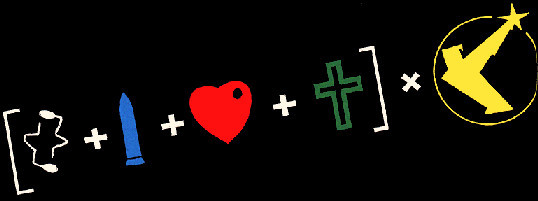
As I create the graphics, I pre-compose Creative Commons attribution strings to go in the post; there's two versions, one for the blog/newsletter and one for Mastodon/Twitter/Tumblr. I compose these manually.
Here's a recent one:
Blog/Newsletter:
(<i>Image: <a href="https://commons.wikimedia.org/wiki/File:QAnon_in_red_shirt_(48555421111).jpg">Marc Nozell</a>, <a href="https://creativecommons.org/licenses/by/2.0/deed.en">CC BY</a>, modified</i>)
Twitter/Masto/Tumblr:
Image: Marc Nozell (modified)
https://commons.wikimedia.org/wiki/File:QAnon_in_red_shirt_(48555421111).jpg
CC BY
https://creativecommons.org/licenses/by/2.0/deed.en
This is purely manual work, but I've been composing these CC attribution strings since CC launched in 2003, and they're just muscle-memory now. Reflex.
These attribution strings, as well as anything else I'll need to go from Twitter to the web (for example, the names of people whose Twitter handles I use in posts, or images I drop in, go into the text file). Here's how the post looks at this point in the composition.
<hr>
<a name="hfbd"></a>
<img src="https://craphound.com/images/20yrs.jpg">
<h1>20 years a blogger</h1><xtagline>Reflections on a lifetime of reflecting.</xtagline>
<img src="https://craphound.com/images/frnklogo.jpg">
See that <img> tag in there for frnklogo.jpg? I snuck that in while I was composing this in Twitter. When I locate an image on the web I want to use in a post, I save it to a dir on my desktop that syncs every 60 seconds to the /images/ dir on my webserver.
As I save it, I copy the filename to my clipboard, flip over to gedit, and type in the <img> tag, pasting the filename. I've typed <img src="https://craphound.com/images/ CTRL-V"> tens of thousands of times - muscle memory.
Once the thread is complete, I copy each tweet back into gedit, tabbing back and forth, replacing Twitter handles and hashtags with non-Twitter versions, changing the ALL CAPS EMPHASIS to the extra-character-consuming *asterisk-bracketed emphasis*.
My composition is greatly aided both 20 years' worth of mnemonic slurry of semi-remembered posts and the ability to search memex.craphound.com (the site where I've mirrored all my Boing Boing posts) easily.
A huge, searchable database of decades of thoughts really simplifies the process of synthesis.
Next I port the posts to other media. I copy the headline and paste it into a new Tumblr compose tab, then import the image and tag the post "pluralistic."
Then I paste the text of the post into Tumblr and manually select, cut, and re-paste every URL in the post (because Tumblr's automatic URL-to-clickable-link tool's been broken for 10+ months).
Next I past the whole post into a Mastodon compose field. Working by trial and error, I cut it down to <500 characters, breaking at a para-break and putting the rest on my clipboard. I post, reply, and add the next item in the thread until it's all done.
*Then* I hit publish on my Twitter thread. Composing in Twitter is the most unforgiving medium I've ever worked in. You have to keep each stanza below 280 chars. You can't save a thread as a draft, so as you edit it, you have to pray your browser doesn't crash.
And once you hit publish, you can't edit it. Forever. So you want to publish Twitter threads LAST, because the process of mirroring them to Tumblr and Mastodon reveals typos and mistakes (but there's no way to save the thread while you work!).
Now I create a draft Wordpress post on pluralistic.net, and create a custom slug for the page (today's is "two-decades"). Saving the draft generates the URL for the page, which I add to the XML file.
Once all the day's posts are done, I make sure to credit all my sources in another part of that master XML file, and then I flip to the command line and run a bunch of python scripts that do MAGIC: formatting the master file as a newsletter, a blog post, and a master thread.
Those python scripts saved my ASS. For the first two months of Pluralistic, i did all the reformatting by hand. It was a lot of search-replace (I used a checklist) and I ALWAYS screwed it up and had to debug, sometimes taking hours.
Then, out of the blue, a reader - Loren Kohnfelder - wrote to me to point out bugs in the site's RSS. He offered to help with text automation and we embarked on a month of intensive back-and-forth as he wrote a custom suite for me.
Those programs take my XML file and spit out all the files I need to publish my site, newsletter and master thread (which I pin to my profile). They've saved me more time than I can say. I probably couldn't kept this up without Loren's generous help (thank you, Loren!).
I open up the output from the scripts in gedit. I paste the blog post into the Wordpress draft and copy-paste the metadata tags into WP's "tags" field. I preview the post, tweak as necessary, and publish.
(And now I write this, I realize I forgot to mention that while I'm doing the graphics, I also create a square header image that makes a grid-collage out of the day's post images, using the Gimp's "alignment" tool)
(because I'm composing this in Twitter, it would be a LOT of work to insert that information further up in the post, where it would make sense to have it - see what I mean about an unforgiving medium?)
(While I'm on the subject: putting the "add tweet to thread" and "publish the whole thread" buttons next to each other is a cruel joke that has caused me to repeatedly publish before I was done, and deleting a thread after you publish it is a nightmare)
Now I paste the newsletter file into a new mail message, address it to my Mailman server, and create a custom subject for the day, send it, open the Mailman admin interface in a browser, and approve the message.
Now it's time to create that anthology post you can see pinned to my Mastodon and Twitter accounts. Loren's script uses a template to produce all the tweets for the day, but it's not easy to get that pre-written thread into Twitter and Mastodon.
Part of the problem is that each day's Twitter master thread has a tweet with a link to the day's Mastodon master thread ("Are you trying to wean yourself off Big Tech? Follow these threads on the #fediverse at @[email protected]. Here's today's edition: LINK").
So the first order of business is to create the Mastodon thread, pin it, copy the link to it, and paste it into the template for the Twitter thread, then create and pin the Twitter thread.
Now it's time to get ready for tomorrow. I open up the master XML template file and overwrite my daily working file with its contents. I edit the file's header with tomorrow's date, trim away any "Upcoming appearances" that have gone by, etc.
Then I compose tomorrow's retrospective links. I open tabs for this day a year ago, 5 years ago, 10 years ago, 15 years ago, and (now) 20 years ago:
http://memex.craphound.com/2020/01/14
http://memex.craphound.com/2016/01/14
http://memex.craphound.com/2011/01/14
http://memex.craphound.com/2006/01/14
http://memex.craphound.com/2001/01/14
I go through each day, and open anything I want to republish in its own tab, then open the OP link in the next tab (finding it in the @internetarchive if necessary). Then I copy my original headline and the link to the article into tomorrow's XML file, like so:
#10yrsago Disney World’s awful Tiki Room catches fire <a href="https://thedisneyblog.com/2011/01/12/fire-reported-at-magic-kingdom-tiki-room/">https://thedisneyblog.com/2011/01/12/fire-reported-at-magic-kingdom-tiki-room/</a>
And NOW my day is done.
So, why do I do all this?
First and foremost, I do it for ME. The memex I've created by thinking about and then describing every interesting thing I've encountered is hugely important for how I understand the world. It's the raw material of every novel, article, story and speech I write.
And I do it for the causes I believe in. There's stuff in this world I want to change for the better. Explaining what I think is wrong, and how it can be improved, is the best way I know for nudging it in a direction I want to see it move.
The more people I reach, the more it moves.
When I left Boing Boing, I lost access to a freestanding way of communicating. Though I had popular Twitter and Tumblr accounts, they are at the mercy of giant companies with itchy banhammers and arbitrary moderation policies.
I'd long been a fan of the POSSE - Post Own Site, Share Everywhere - ethic, the idea that your work lives on platforms you control, but that it travels to meet your readers wherever they are.
Pluralistic posts start out as Twitter threads because that's the most constrained medium I work in, but their permalinks (each with multiple hidden messages in their slugs) are anchored to a server I control.
When my threads get popular, I make a point of appending the pluralistic.net permalink to them.
When I started blogging, 20 years ago, blogger.com had few amenities. None of the familiar utilities of today's media came with the package.
Back then, I'd manually create my headlines with <h2> tags. I'd manually create discussion links for each post on Quicktopic. I'd manually paste each post into a Yahoo Groups email. All the guff I do today to publish Pluralistic is, in some way, nothing new.
20 years in, blogging is still a curious mix of both technical, literary and graphic bodgery, with each day's work demanding the kind of technical minutuae we were told would disappear with WYSIWYG desktop publishing.
I grew up in the back-rooms of print shops where my dad and his friends published radical newspapers, laying out editions with a razor-blade and rubber cement on a light table. Today, I spend hours slicing up ASCII with a cursor.
I go through my old posts every day. I know that much - most? - of them are not for the ages. But some of them are good. Some, I think, are great. They define who I am. They're my outboard brain.
37 notes
·
View notes
Text
First Journal for Web Design Spring 2019
1/18/2019
My History with Web-Design:
The first time I ever considered web design was last semester during the intro to design class where we were told to design one. It was horrible, I had no idea how to even approach it and ended up just throwing pixels at a screen until I technically put in enough work to justify turning the project in. I never even thought about websites before then as I always saw them as inconvenient mediums to whatever content I wanted. This reminded me of when I first started in graphic design and literally couldn’t tell the difference between Futura and Baskerville by just looking at them because of how new this field of design was to me. The panic of the oncoming slaughter that would be known as class 576 pushed me to research as much as I could into the field, especially in how to physically make the websites with code. I focused on code in part because of my experience in Adobe programs. Before I can make an illustration in Illustrator, I need to know the mechanics of the program so that I can work at the speed of thought without being stumped. I saw learning how to code as just the web design version of that, though to a certain point I think I was confusing being able to do whatever I want in the browser with being able to design things that are worth making.
I’m coming into this semester very excited for learning how to design for the web.
The First Project Process:
The assignment was to make a website focused on three things that were our favorites in a category of our choice. I may have misunderstood the prompt a little as I thought we were supposed to make a site to house three article listing three of our favorite things in three different categories, rather than one website acting like the article itself listing the three favorites in only one category that the website is entirely dedicated to. I started in my sketchbook before touching the computer just to get some ideas out before I jumped into the computer with no direction and find myself a deer in the Adobe RGB headlights.
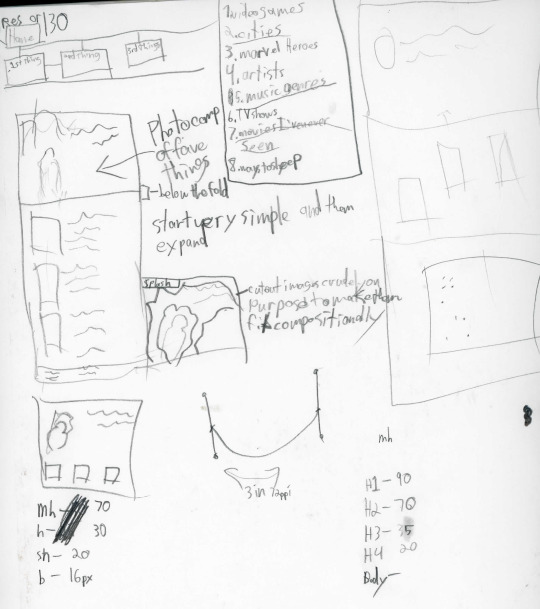
Making the initial wireframe in Photoshop was not an issue, save for some elements that found themselves on the same layers as each other which made editing later difficult because moving objects in Photoshop is difficult when they’re sharing layers. I wrote the colophon in my notes as analog paragraph styles instead of trying to work with whatever nightmare Photoshop’s version of styles must be like. I eventually started doing the text in Photoshop to save me the trouble of having to replace everything from InDesign everytime I wanted to change anything, as per Michael Jared’s recommendation.
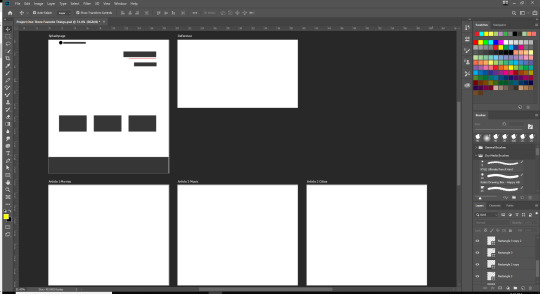
The problems I started having in Photoshop was when I started working with photos. Usually, I love using PS for photo editing and photo-comps but using it as a layout software is frustrating as each resizing requires manual rearrangement of everything on the page. Making things more difficult was the problem of multiple objects being on the same layer coming back, as they had different rules for how they need to move I needed to constantly code switch between the free objects and the layered ones.
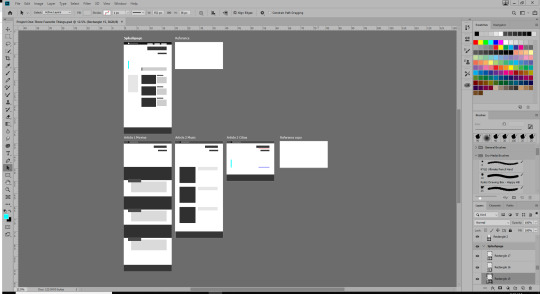
After there were a few basic sketches done using shapes and a system of values to denote the difference between images, texts, and sections, I started populating the file with content, slowly phasing out the shapes. I’m embarrassed to say that the design decisions I made were solely based on the intuition that I don’t have. I decided on a landing page design of a bleed image with some big text over it because that’s what I see on all the web design Instagrams, which is pretty much the only place that I get around to seeing any web design examples for my still shallow internal visual library. The placement of the text and images in a strict and boring grid was based on instinct and my incompetence with working in Photoshop for this purpose completely stunted my ability to explore any other options.
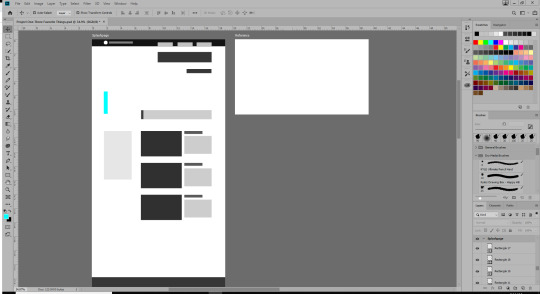
The minimalism in my designs come from my instinct to remove anything unnecessary out of a fear that the alternative is just a mess of content and design elements that I wouldn’t know how to make work. I’m retreating into minimalism because I’m often at a loss for ideas, inspiration, and confidence. I think this has worked out for me a lot in the past as I understand the way to make low detailed content work is to make sure there’s more attention given to each piece of that content, but at the same time I don’t want it to be something I have to do, but rather something I want to do. There is also the issue that I often find my work to be very boring and derivative. The landing page above just reminds me of YouTube, the website that I’m on the most. During the wireframe portion of this design, I was feeling very confident in it and I loved the way it looked. That is until I realized how simple it was and reflected on how little exploration I really did. I fluctuate drastically between feeling overly arrogant and wondering how I could ever survive in this program, something that I expect a lot of designers could relate to.
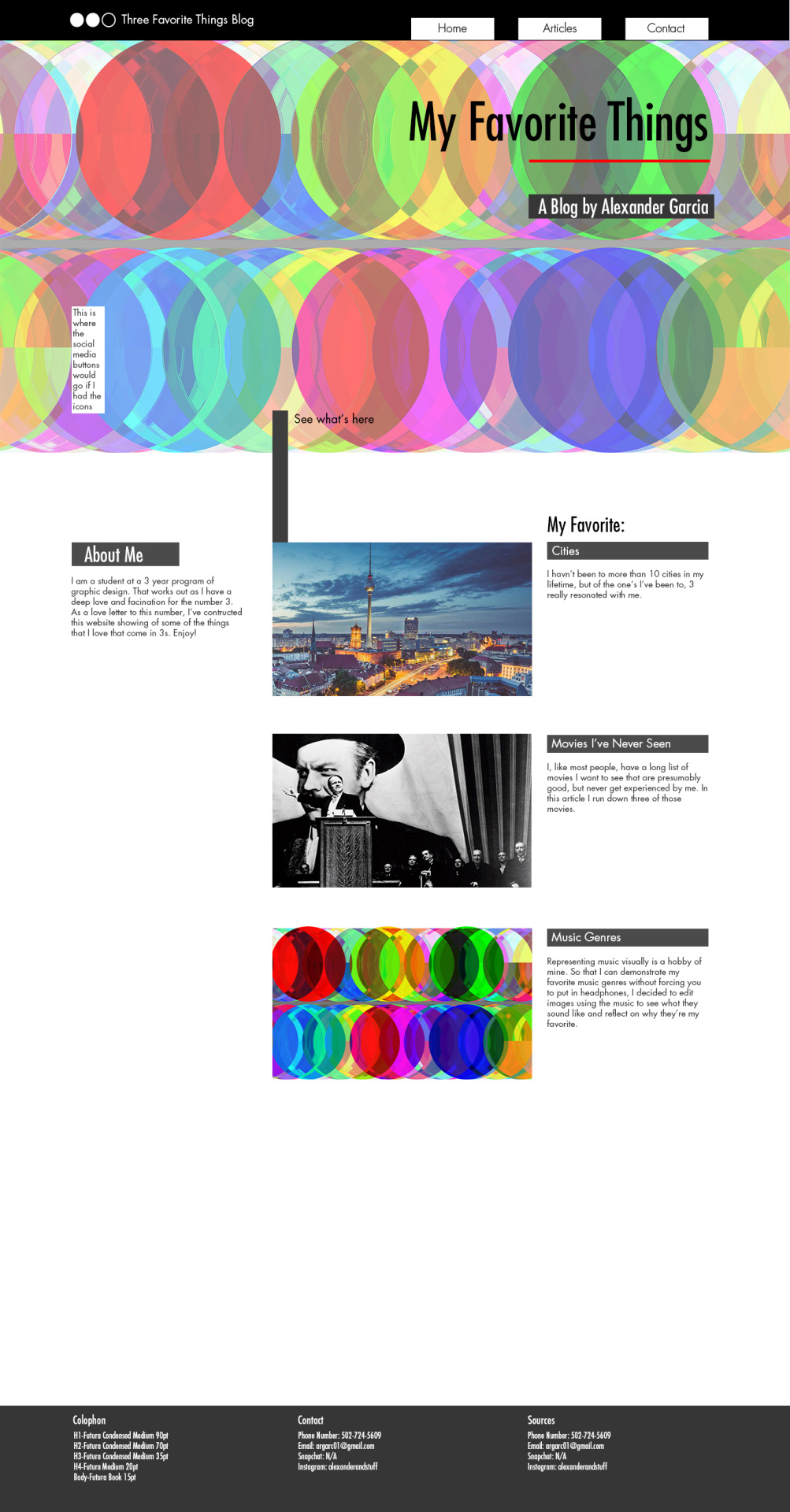
The image above is of the splash page for the website.

The image above is the article featuring my favorite music genres. The part of the project I’m still mostly proud of was my work with data-bending. I love the process of designing procedural rules for how art should be created rather than creating the final product itself. I put images into Audition and edited them using soundwaves similar to the genres I was showcasing as my favorite to demonstrate how they look in the context of the image I used here with basic shapes and colors. What I wanted was to mix specific songs with the image to produce a more specific result. When I figured out how to do that the final product did not look very good because of hardware compromises I had to make. When I tried to use the image at the highest quality it was 1 hour and 45 minutes long, which meant the song had to be just short of that in length to be mixed properly. I still don’t know if this would work in producing something aesthetically pleasing, you never do until you see the result, but I would like to have experimented with that if my computer had enough RAM for the operation. It’s normal for only 1 in 10 images mixed with sound to look any good at all in my experience, which means experimenting many times in a short time frame is critical to using the medium effectively.
On Code:
I’ve been reflecting on my resistance to learning a bunch of new programs for future projects. I think a part of it is that I struggle to learn new programs through experimentation, but rather extensive tutorials that walk me through the sensory overload of icons, options, and settings. Before the semester I put so much time into making code the thing that I learned that I was a little disheartened to learn I would have to do the same for a bunch of other programs, but I think it will be fine. When I decided to learn code I promised myself I would never limit my design to what I could do with code, but rather learn how to do it later, and as long as I approach these programs with the same philosophy, then while it might be frustrating and time-consuming to learn how to do what I want, it should be more than doable since they are designed for web design, unlike Photoshop. Apparently, engineers think Photoshop is designed for this kind of work, they’re wrong and that’s why I’m not an engineer, that and I’m bad at math.
One of the things I did in preparation for this class was learn how to code. I started to do this because the idea of using illustrator and XD to make images of the idea of a website rather than actually making the website frustrated me and sounded like it was adding extra unnecessary steps. I was approaching code the same way that I approached any adobe program, it was just something I learned the mechanics of so that I didn’t have to learn while I designed or limit my designs to what I knew how to code. This is the same as in illustrator or Photoshop where I need to sketch out a design and hope that it’s possible to learn how to do in the program. The key with code, that I didn’t realize before I started learning it, is that there are almost no limitations or hoops to jump through. If I want to do something with the website, I just type it and it happens, and if that something is complicated then instead of spending an hour on google looking for a setting that lets me do in like is Illustrator, I just break it down into smaller steps and do it. It makes me feel like I’m no longer being limited by the technology when I code because it’s so clear what I can and can’t do.
It’s not that I think my first project would have been leaps and bounds better without Photoshop, I don’t mean to blame Photoshop for my shortcomings with the design, but there were some things that I simply couldn’t do because I couldn’t figure out how the makers of Photoshop wanted me to do it, such as changing the colors of shapes, and Google was no help on this issue. The other reason that coding has felt natural to me is how intuitive it is to start with nothing and build out. In the Creative Cloud, I am given every tool to use right when I open the program, and it’s information overload. I often have nowhere to start and in worst cases, I get genuinely claustrophobic because I don’t know what I’m looking at until I spend at least 10 or so hours being walked through the interface by tutorials. Coding is the exact opposite workflow. Instead of starting with everything and adding rules, slowly making everything more organized and follow those rules and hoping you don’t miss anything, coding starts organized and with every rule and restriction you could ever have because of the defaults, and I work at my own pace to slowly usurp those defaults and write my own rules for how the website should be. It forces me to set the foundations for the design and work out, rather than forcing every idea I have into one document like I tended to get myself in trouble doing in the past. It also forces me to keep the design structured. When it’s in code I feel like there’s a backbone to the site, and I’m building the body on top of it, as opposed to InDesign which feels like I’m just throwing pixels at a screen blindly and hoping that it works. My brain just responds better to the amount of control you get with coding things, which is not something I expected when I first started learning it.
The disadvantage of code is a significant one. The organization and the foundational nature of it does not lend itself well to exploration. If I want to change something fundamental about the design, then I would have to do a significant amount of reworking, whereas with Photoshop I was able to change the core design ad hoc until I liked it. I had very little issue doing my initial sketch, or wireframe, in Photoshop, and I think it’s necessary to start with sketching in a notebook and then moving to a sketching application. So, in an Ideal world I would do the sketching and wire-framing in my sketchbook and Illustrator, and then make the final version in code where I’m not limited to what Illustrator is okay with me doing. I am hoping that Adobe XD will provide the best of both worlds. Where I can change things on the fly without cutting and pasting a ton of text and hoping I didn’t make a mistake when doing so, which is what Illustrator provides and being functionally structured enough that I don’t get overwhelmed, which is the benefit of code. I intend to try coding my websites after making them in these prototyping programs to polish my skills in code and to boost my self-confidence, but I will not make it a priority until it’s time to make fully functional websites, at which point I’ll get Susan to teach me GitHub.
Wrap-Up:
As I said before, I fluctuate between being overly confident and feeling like there’s no way for me to survive in this program. When I was coming into this class I was in the overconfident stage, and after critique where I saw everyone else's work, I’m shifting into the other stage. Based on the work that I’m doing in this class and in Typography 2, I’m starting to feel concerned that I haven’t actually improved in the past 8 months or so, but instead just learned a couple of rules to make something look good despite not having a great concept behind it. Whenever I do something that I’m very proud of It’s usually an accident that I run with, which is an observation I’m not totally uncomfortable with. I know that I’ve improved at least some despite my doubts, and I’m proud of my ability to see the beauty in mistakes when I’m working that often leads to the final works that I end up being the proudest of.
I had a lot of plans of doing a ton of self-directed projects this semester considering I have plenty of time for it, but after a couple weeks I’m deciding to cut those expectations of myself down in favor of focusing much more heavily on my classes and developing specific side skills that I’ve wanted for a long time, such as the ability to code and draw. I’m also making it my goal to become more proactive on social media and build a designer presence there to the best of my ability. With all that and finally getting the new computer I’ve wanted for so long this weekend, I think it’s been an acceptable start to this semester.
1 note
·
View note
Text
Context of Game and Play - Reading Analysis: Week 5 (Culture)
Things of Beauty: Super Smash Bros. as Spectator Sport
Currently this has been one of the most fascinating things I have cover on this paper. This may be due to its focus on fighting games and that is what got me into video games (That game was Tekken 3). I know what Evo is and understand competitive fighting game terms. Thus, I was immediately impressed by the rapid reactions need to parry that long super art combo. This was made more impressive by the fact that Diago was unable to take a single hit. Moments like these can cause adrenaline rushes and throw the players and audience into disbelief.
He then went on to talk about the battle between Mew2King and aMSa, where aMSa used a Yoshi to beat Mew2King’s Fox and Sheik (Innuendo Studios, 2015). Going into the battle aMSa had a lot of doubters, due to Yoshi being low tier and not being used in a competitive setting. Before, I elaborate on this; I will go over a few other points he made.
For starters, the biggest difference between a sport and competitive video game.
Sports: You can do anything that is not expressly forbidden by the rules.
Video Game: You cannot do anything except what is expressly allowed by the system.
He gives a good explanation with his Fifa example. Where in games there are some mechanics that were intentionally programmed in like shield drops (Super Smash Bros) and some that were discovered and created by the player. E.g. Wave dashing (I will talk about this later).
Sometimes, these mechanics can relate to character potential where there exist some techniques that are yet to be discovered; which can dramatically improve the character’s standing in the competitive scene. This can catch a professional off guard, because they have not trained against it. E.g. Pitching s knuckle ball in baseball.
From personal experience, I do not play games at a high competitive level. But, I have a strong following toward Tekken and Overwatch. i tend to follow Overwatch due to it being something that i enjoy. But, just like the speaker’s loyalty to Captain Falcon; I am loyal to Tekken for the same reason.
Some examples to mechanics that were discovered by the players in Tekken, were the wave dash and the Korean back dash.
youtube
(Xian 鉄拳, 2016)
These moves can only be done by certain characters. Basically, a wave dash is a technique to quickly close in the distance with the other player; while staying on guard and allowing your character to quickly execute an attack. On the other hand, the Korean wave dash is the same thing but done backwards and used to create distance. Neither move was intentionally designed, yet they have become a stable part of tournaments.
After watching the video, it actually made me go and watch some Overwatch competitive matches and observe the crowd, players and commentators behaviours.
Year In Review
(Kunzelman, n.d.)
So............... this is a thing. Well where to start? No seriously, I have no idea where to start; I just don’t get it and cannot find any information online.
For starters, all I have to do is press the “N” or “O” key to keep the character’s head above the water. Each press, adds 1 to your score. The end result is just shows a screen saying that “2015 was a (score) out of 10.”. Predominantly, the end result just says a (Large number) out of 10. The only relationship that I can draw was that 2015 was a really good year for video games, thus the character is drowning in these game.
A quick rundown on the games of 2015:
youtube
(GameSpot, 2015).
Salve Of God
This freaking game gave me one hell of a headache and ruined my sleep. I didn’t get it at all, the only thing I felt was intense anger; because of how it affect my body. As a result, I took some time off from this paper.
After an intense Muay Thai session, I felt significantly better and had a clearer perspective on the project. I realised that this project is similar to what we want to do, for our Game Jam. However, I found the game very faulty and terribly designed. I understood fuck all after watching a walkthrough and felt that was overly artsy fartsy. To be honest, I was in utter shock when I discovered there actually existed a story. The game ends once you understand it, which is just incomprehensible.
After reflecting on my thoughts I decided to do some research and this drastically altered my perspective. I learnt that the game was about obsessive drug usage, drinking and clubbing (Ellison, 2013). The trippy atmosphere was a result of being high and reacting to all the colours and loud music in the nightclub.
Upon further thought, it was a very well executed project. I can now see how it builds up and immerses the user in a nightclub and drugged environment. This was emphasised by the randomness yet logical actions need to complete the game.
In conclusion, the meaning itself may explain why I disliked the project so much. I do not enjoy clubbing, despise the taste of alcohol and have not done drugs before. Thus, explaining why I felt very uncomfortable in this environment. However, the only link between this and culture that I can see is probably druggie culture.
Set and Setting
("Set and setting," n.d.).
Another reading that i struggled with. It makes sense, yet I don’t get its relationship to culture.
Set is the mental state that a person takes with them into the experience. Setting is the physical and social environment.
Furthermore, this describes the context of certain psychedelic drugs. Where their mental state effects their setting. In the end, i just don’t get it and the importance of this toward culture.
Cyberqueen
Well that’s enough internet for me. What the actual hell is this game? I was either invested, bored out of my mind, or weirded out. The game itself is a choose your own text adventure game with very graphic scenes implied thru text. The last few moments of the game can be summarised into 2 options you can either preform surgery or masturbate.
Once again, I do not get the importance of this project or why it was selected as a reading. Then again it can be harder to understand foreign cultures. This would explain my outside perspective and lack of understanding on this certain culture. Therefore, the foreignness of this culture makes it harder for me to understand and relate to stories about masturbation and surgery.
Dr. Langeskov, The Tiger, and The Terribly Cursed Emerald: A Whirlwind Heist
(Crows Crows Crows, 2015).
Wow just wow, this game has really gotten me thinking; about game design and new ideas for games. I ended up spending 64 minutes playing this game. It felt very interesting and open-ended, yet it was extremely linear. \
The game itself was about being someone in the background of a game and ensure that it runs properly, for the player currently in that supposed game. This made me feel like I was inside a game and was playing as a function in the code. This made sense as I had to execute certain actions and was frequently being told about the game. Furthermore, my actions hindered the process and did not break the system; due to the “programmers” implementing exceptions and counters to my random behaviour.
When playing through the game a second time, I came across the tape player that added more intrigue to the project. That referenced other ideas the supposed “designers” had. With one of the games being about getting attack by pencils, then having to take off all your clothes, run to the hills and hiding in a bush. This would explain why most rooms had at least 1 pencil.
The project itself explores developer culture and showcasing the feedback and problems they experience. This is something that we can all kind of relate to.
Serenity Now
(VonArens, 2008), (Gibbs, Carter, Arnold, & Nansen, 2013)
This was very savage to watch and read into. I felt a bit disgusted by Serenity Now’s actions. However, I do not feel as though they are in the wrong. I felt disgusted due to moral reasons, because Illidan-US were holding a funeral and tribute to their lost friend. The fact that they were targeted and massacred at a time of grief and is bad enough.
On the other hand, the service was held in a PvP location and that killing other players is part of the game. Technically, Serenity Now was just playing the game. Everyone who purchased the game should be given equal access. Therefore, the fact that certain players were holding a funeral; should not force everyone else to stop playing the game or restrict access to said area.
Yet, there are being targeted due to taking immoral actions; even though these are programmed mechanics that the developers intended. Interestingly, the players have formed their own cultures within the world where they hold events upon certain occasions; e.g. Marriage. Nonetheless, the developers never really programmed the idea of culture; nor did the designers design it. This leads to the question as to what is more important.
What is ontology? Introduction to the word and the concept
(Löfgren, 2013).
Basically ontology is the study of what exists. These raise quiet a few questions as to are physical parts more real than their immaterial actions. E.g. Shoes and walking.
This has an interesting link to culture, where culture itself does not physically exist. Yet, it has such a major influence on our world and is an indicator on human separation. Nevertheless, the idea and relationship to culture is dramatically self-explanatory.
References:
Innuendo Studios. (2015, August 19). Things of Beauty: Super Smash Bros. as Spectator Sport [Video file]. Retrieved from https://www.youtube.com/watch?v=8qxVDOc-oV8&feature=youtu.be&ab_channel=InnuendoStudios
Xian 鉄拳. (2016, January 18). Handwarmers - Korean Backdashing and Wavedashing [Video file]. Retrieved from https://www.youtube.com/watch?v=I3lTQMa31Uk&ab_channel=Xian%E9%89%84%E6%8B%B3
Kunzelman, C. year in review [Web Browser game].
GameSpot. (2015, December 31). The 2015 Video Game Year In Review [Video file]. Retrieved from https://www.youtube.com/watch?v=AbtMT6jh7oI&ab_channel=GameSpot
increpare games. (2012). Slave Of God [Computer Software].
Ellison, C. (2013, January 4). Wot I Think: Slave Of God | Rock, Paper, Shotgun. Retrieved from https://www.rockpapershotgun.com/2013/01/04/slave-of-god-review/
Set and setting. (n.d.). Retrieved March 30, 2017, from https://en.wikipedia.org/wiki/Set_and_setting
Crows Crows Crows. (2015). Dr. Langeskov, The Tiger, and The Terribly Cursed Emerald: A Whirlwind Heist [Computer Software].
VonArens. (2008, December 8). Serenity Now - Crash a Funeral in Winterspring Gaming [Video file]. Retrieved from https://gaming.youtube.com/watch?v=YgXW-cKI1bw&feature=share
Gibbs, M., Carter, M., Arnold, M., & Nansen, B. (2013). Serenity Now bombs a World of Warcraft funeral: Negotiating the Morality, Reality and Taste of Online Gaming Practices. Retrieved from http://marcuscarter.com/wp-content/uploads/2014/05/AoIR-WoW-Funeral-Final.pdf
Löfgren, K. (2013, February 15). What is ontology? Introduction to the word and the concept [Video file]. Retrieved from https://www.youtube.com/watch?v=XTsaZWzVJ4c&feature=youtu.be
1 note
·
View note